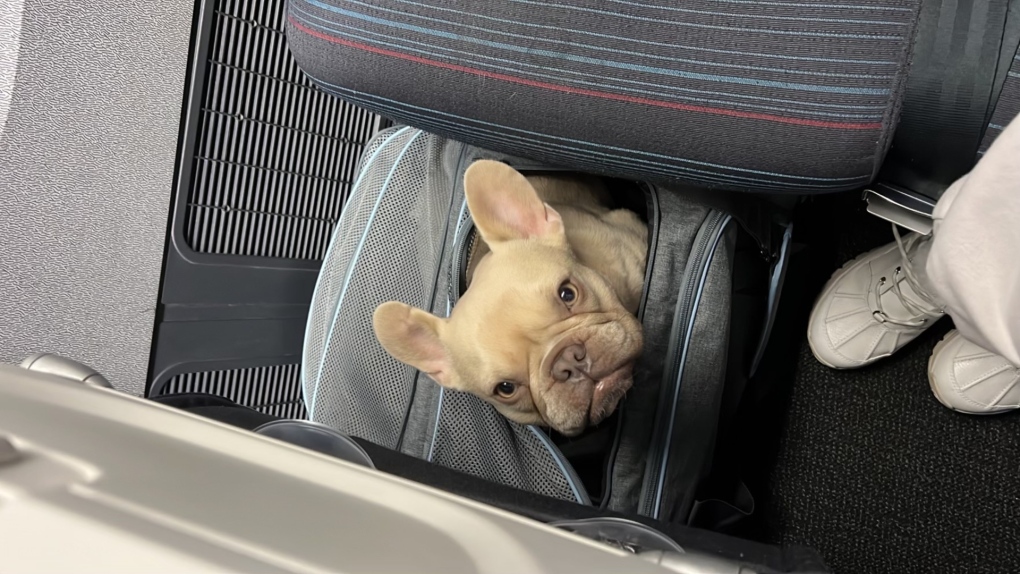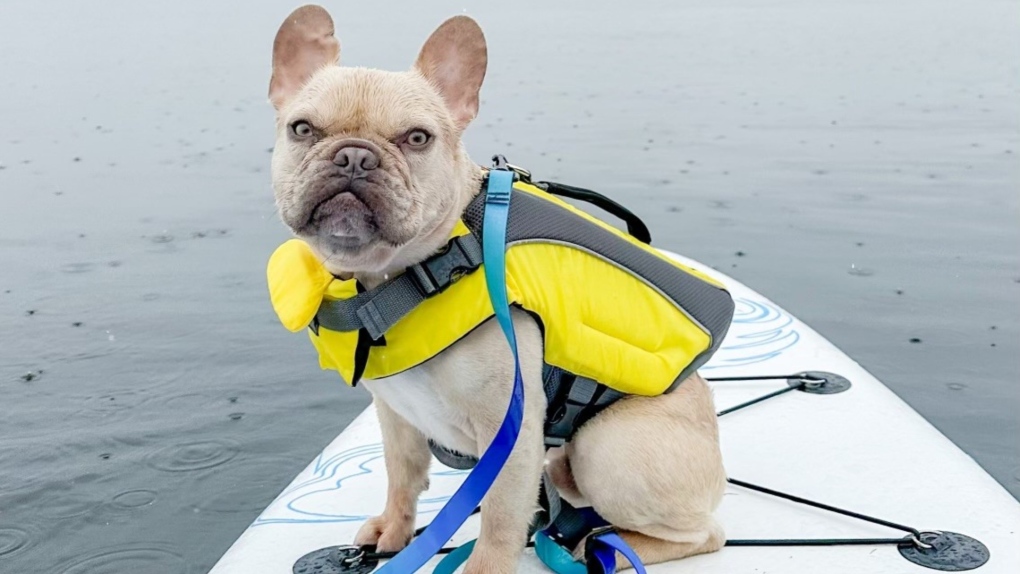Flying with a pet this summer? Here's why you should plan ahead
Wen-Ling Lin moved from Vancouver to Toronto for work, and often flies home to see her friends and family.
“We love taking Kygo on trips. He is obviously the best travel companion and we want to show him the world. He is my fur baby," Lin told CTV News Toronto.
Lin said she has taken her two-year-old French bulldog Kygo to Vancouver six times and each time the experience went very well.
“The carrier sits right below my feet. He just sits in it and he goes to sleep usually. We zip it up and he goes right underneath the seat," said Lin.
Since Kygo is a smaller dog, he is allowed to be in the cabin with Lin. However, larger dogs may have to stay in a pet crate that will go in checked luggage or cargo.
 Kygo on board the plane's cabin. (Supplied)
Kygo on board the plane's cabin. (Supplied)
No matter where your pet is on the plane, the Toronto Humane Society says flying can be a traumatic experience for them, adding careful consideration should be made before bringing a pet on board an airplane.
“For some animals they are really stressed when they are away from home. The travel itself can also be quite difficult for them,” Linda Jacobson of the Toronto Human Society said.
If you do decide to fly with your pet, you may need a health certificate with vaccination status. It is also recommended that you carefully research pet size and weight requirements beforehand, and if you’re travelling to another country, finding out if it’s necessary to have your pet placed in quarantine on arrival.
Your pet should have an identification tag with your phone number and be microchipped. Lin takes the extra step of also using an AirTag on her dog just in case he would go missing.
“The AirTag is just added protection if he would wander off,” said Lin.
While some owners may be tempted to give their pets a sedative to calm them down before a trip, Jacobson said that should only be done under a veterinarian’s supervision.
“There are some mild sedatives that could potentially be used, but it is a little more difficult if they are not in front of you and in the cargo area, because you really want to keep an eye on them. So, you will definitely want to discuss that with a veterinarian,’ said Jacobson.
 Kygo wearing a lifevest on a paddleboard. (Supplied)
Kygo wearing a lifevest on a paddleboard. (Supplied)
Lin says Kygo has become a good flier, adding she gives him lots of exercise the day of the flight so he will be tired and sleep on the plane.
The cost to fly with a pet varies from $50 to $120 for domestic flights and can be about $300 for international flights, with airlines typically allowing two to four pets in the cabin per flight.
Lin said while flying with Kygo takes extra planning for her, it’s worth it.
“My family also loves Kygo, so anytime I’m going back home they say, ‘Are you bringing Kygo with you?’” said Lin.
When flying with a pet, try opting for direct flights, avoid busy travel times and contact the airline in advance.
CTVNews.ca Top Stories

Widow looking for answers after Quebec man dies in Texas Ironman competition
The widow of a Quebec man who died competing in an Ironman competition is looking for answers.
Amid concerns over 'collateral damage' Trudeau, Freeland defend capital gains tax change
Facing pushback from physicians and businesspeople over the coming increase to the capital gains inclusion rate, Prime Minister Justin Trudeau and his deputy Chrystia Freeland are standing by their plan to target Canada's highest earners.
Tom Mulcair: Park littered with trash after 'pilot project' is perfect symbol of Trudeau governance
Former NDP leader Tom Mulcair says that what's happening now in a trash-littered federal park in Quebec is a perfect metaphor for how the Trudeau government runs things.
U.S. Senate overwhelmingly passes aid for Ukraine, Israel and Taiwan with big bipartisan vote
The U.S. Senate has passed US$95 billion in war aid to Ukraine, Israel and Taiwan, sending the legislation to President Joe Biden after months of delays and contentious debate over how involved the United States should be in foreign wars.
Wildfire southwest of Peace River spurs evacuation order
People living near a wildfire burning about 15 kilometres southwest of Peace River are being told to evacuate their homes.
World seeing near breakdown of international law amid wars in Gaza and Ukraine, Amnesty says
The world is seeing a near breakdown of international law amid flagrant rule-breaking in Gaza and Ukraine, multiplying armed conflicts, the rise of authoritarianism and huge rights violations in Sudan, Ethiopia and Myanmar, Amnesty International warned Wednesday as it published its annual report.
Train derailed in Sarnia after colliding with a truck
Police are investigating after a transport truck collided with a train in Sarnia.
Fewer medical students going into family medicine contributing to doctor shortage
As some family doctors are retiring and others are moving away from family medicine, there are fewer medical students to take their place.
'It's discriminatory': Individuals refused entry to Ontario legislature for wearing keffiyeh
Individuals being barred from entering Ontario’s legislature while wearing a keffiyeh say the garment is part of their cultural identity— and the only ones making it political are the politicians banning it.

































